Beheading (Decapitation) Traditions in the Scriptures
Beheading (Decapitation) Traditions in the Scriptures and
in Post–Book of Mormon Ancient American Cultures
by Mark F. Cheney
Copyright © 2015
Although this article may seem like a gruesome undertaking, beheadings are well known in the scriptures and in the ancient world. Perhaps the most famous beheading in the Christian world is that of David’s act after slaying the giant, Goliath (1 Samuel 17). Of interesting note is the fact that he performed the deed with the victim’s own sword, which may be noteworthy as a possible part of some tradition in itself.
Following are some Old Testament references to decapitations:
And they took two princes of the Midianites, Oreb and Zeeb . . . and brought the heads of Oreb and Zeeb to Gideon. (Judges 7:25)
And as David returned from the slaughter of the Philistine, . . . [he] brought . . . the head of the Philistine in his hand. (1 Samuel 17:57)
They cut off his head and stripped off his weapons, and sent them throughout the land of the Philistines, to carry the good news to the house of their idols and to the people. (1 Samuel 31:9)
And they smote him, and slew him, and beheaded him, and took his head . . . [and] brought the head of Ishbosheth unto David. (2 Samuel 4:7–8)
Then said Abishai the son of Zeruiah unto the king, Why should this dead dog curse my lord the king? let me go over, I pray thee, and take off his head. (2 Samuel 16:9)
And they cut off the head of Sheba the son of Bichri, and cast it out to Joab. (2 Samuel 20:22)
They took the king’s sons, and slew seventy persons, and put their heads in baskets, and sent him them to Jezreel. And there came a messenger, and told him, saying, They have brought the heads of the king’s sons. And he said, Lay ye them in two heaps at the entering in of the gate until the morning. (2 Kings 10:7–8)
They were all overcharged with wine. . . . But Holofernes lay on his bed, fast asleep, being exceedingly drunk. . . . Judith stood before the bed praying. . . . Strengthen me, O Lord God of Israel . . . that I may bring to pass . . . that it might be done by thee. . . . When she had said this, she . . . loosed his sword. . . . And . . . she took him by the hair of his head, and said: Strengthen me, O Lord. . . . And she struck twice upon his neck, and cut off his head. . . . And after a while she went out, and delivered the head of Holofernes to her maid, and bade her put it into her wallet. (Judith 13:2–11)
And here are some New Testament references to beheadings, notably, John the Baptist’s:
And he sent, and beheaded John in the prison. (Matthew 14:10; emphasis added)
But when Herod heard thereof, he said, It is John, whom I beheaded: he is risen from the dead. (Mark 6:16; emphasis added)
And immediately the king sent an executioner, and commanded his head to be brought: and he went and beheaded him in the prison. (Mark 6:27; emphasis added)
And Herod said, John have I beheaded: but who is this, of whom I hear such things? And he desired to see him. (Luke 9:9; emphasis added)
And I saw thrones, and they sat upon them, and judgment was given unto them: and I saw the souls of them that were beheaded for the witness of Jesus, and for the word of God, and which had not worshipped the beast, neither his image, neither had received his mark upon their foreheads, or in their hands; and they lived and reigned with Christ a thousand years. (Revelation 20:4; emphasis added)
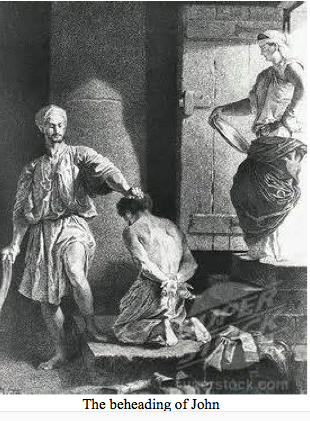
In the Book of Mormon, the best known decapitation occurred in the story of Nephi and Laban, where Nephi found Laban passed out in the street in a drunken condition. Nephi reluctantly, given his youth and pure nature, followed the Lord’s instruction to “slay him” by taking “Laban by the hair of the head, and . . . smote off his head with his own sword” (see 1 Nephi 4:8–18).
In Hamblin and Merrill’s “Swords in the Book of Mormon,” chapter 15 of Warfare in the Book of Mormon, they state, “Nephi’s method of beheading Laban by grasping his hair to pull up the head and expose the neck is a common technique (see figure 2).” Figure 2 is reproduced here and is a line drawing of “Rameses III grasping the hair of his enemies as he beheads them, from a relief at Medinet Habu, XXth Dynasty (1192–1160 BC).” 1 Another more obscure instance of beheading anciently in Mesopotamia is found on page 39 in the same book.
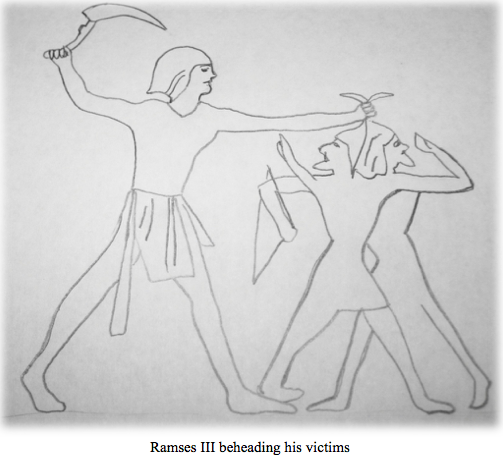
The next most notable instance in the Book of Mormon of a beheading is that of Coriantumr’s killing and taking the head of Shiz in the final battle of the Jaredites:
And it came to pass that when Coriantumr had leaned upon his sword, that he rested a little, he smote of the head of Shiz. And it came to pass that after he had smitten off the head of Shiz, that Shiz raised up on his hands and fell; and after that he had struggled for breath, he died. (Ether 15:30–31)
Some writers believe that Stela 21 at the ancient site of Izapa, Mexico, represents this beheading of Shiz in the Book of Mormon. As can be seen below, the victim, whose blood is pumping from his neck, is raising himself up on at least one hand. The scene in Stela 21 seems very similar to that of Laban’s beheading by Nephi.
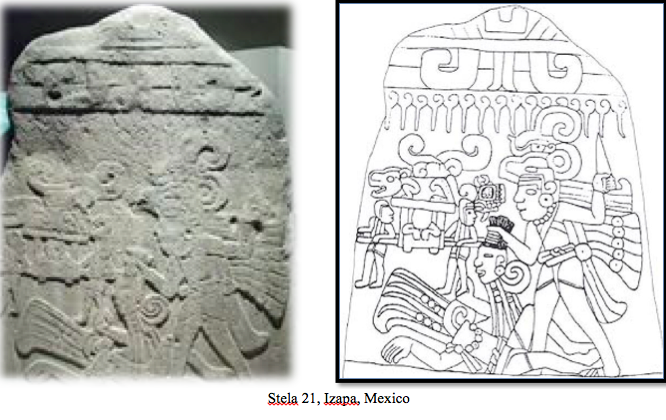
The Rogan Plates are a collection of Mississippian copper plates found in Mound C of the Etowah Indian Mounds near Cartersville, Georgia, by John P. Rogan, working under Cyrus Thomas of the Smithsonian Institution in the early 1880s. They also bear some remarkable similarities to Maya sculptures found in the Yucatan Peninsula. Both of these plates depict what has been called the “Falcon Dancer” or “Birdman.”
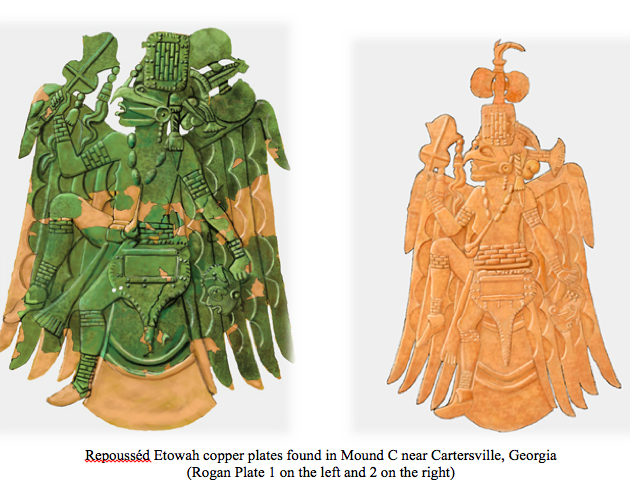
A number of interesting motifs similar to those found in Mesoamerican and Aztec art can be seen in Rogan Plate 1. The falcon or eagle image is common—not too surprising or very significant in and of itself; but then there is the interesting, downward-pointed satchel or apron in the center of the plate, a sword or weapon in the right hand, and the head of a supposed enemy in the left hand.
Another plate with some definite connections to the Rogan Plates is the Copper Solar Ogee Deity Plate found at Lake Jackson Mound Site, Florida. This plate has a similar weapon raised in one hand and the severed head in the other.
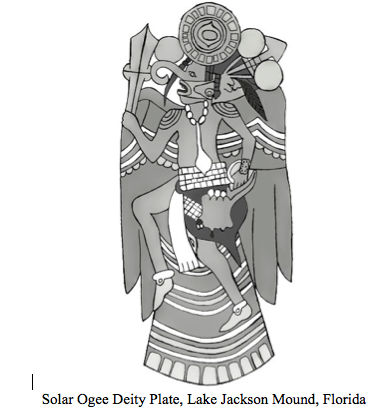
In two wall carvings from Chichen Itza, some of the similarities between them and the Rogan Plate can be observed. The so-called “Winged Warrior” wall carving in Chichen Itza has a number of comparables. First, the name itself indicates a bird motif similar to the “Dancing Falcon.” Second, the warrior holds a weapon in his right hand and a severed head in his left. And third, flying serpents are also part of the decoration.

Winged Warrior, Chichen Itza
Comparisons with wall carvings in Chichen Itza can be seen in the Quetzalcoatl or Feathered Serpent Warrior. Here, in his right hand, the warrior again carries a weapon that appears to be a serpent-shaped club or macana, and the now-familiar severed head, with gushing blood, is in his left hand. These are interesting similarities to the North American examples, to be sure, but the beheading appears to be ubiquitous throughout ancient cultures.
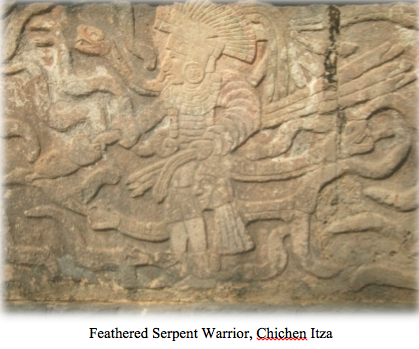
This article shows common traditions of beheadings in the Old World and the New World and may not really prove anything; however, neither does it leave the question unanswered as to whether traditions in the Book of Mormon are closely comparable to those in the Near East, the given land of both Jared’s and Nephi’s fathers.
Note
[1]. Stephen D. Ricks and William J. Hamblin, eds. Warfare in the Book of Mormon (Salt Lake City: Deseret Book and Provo, UT: FARMS, 1990), 335–36.


